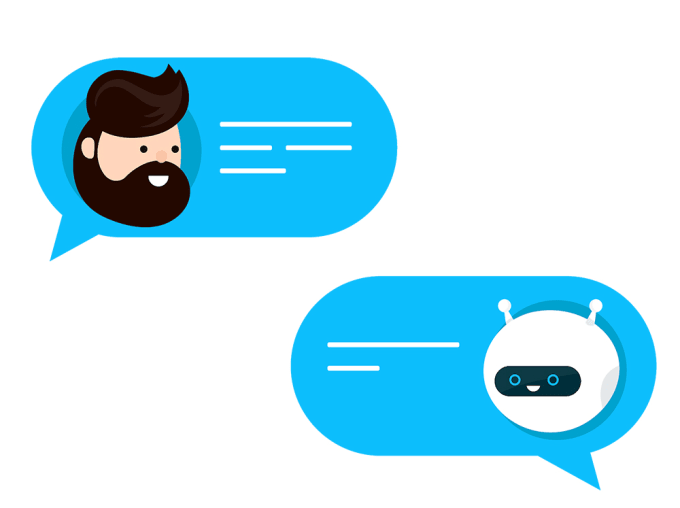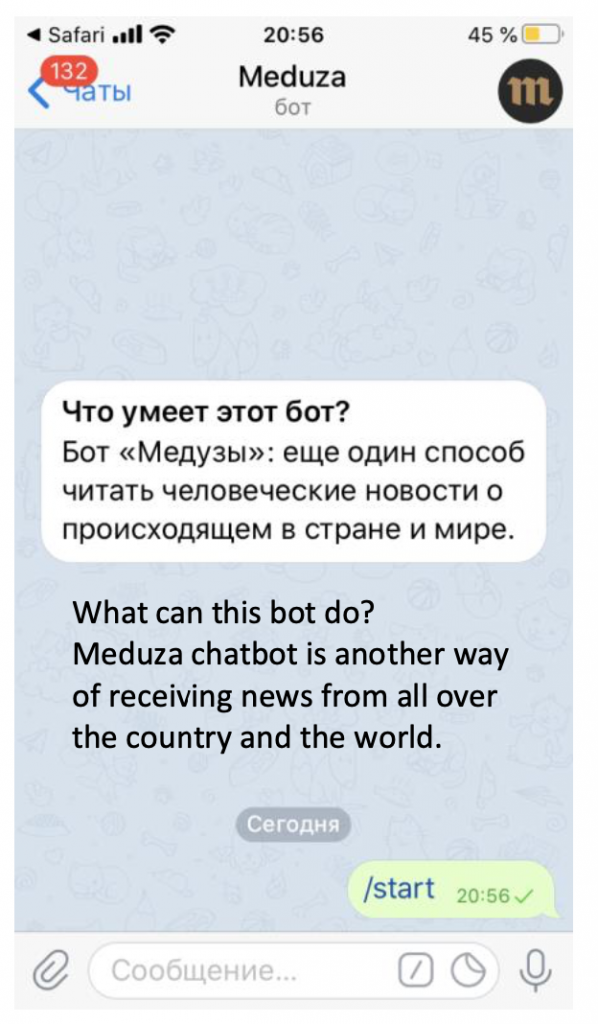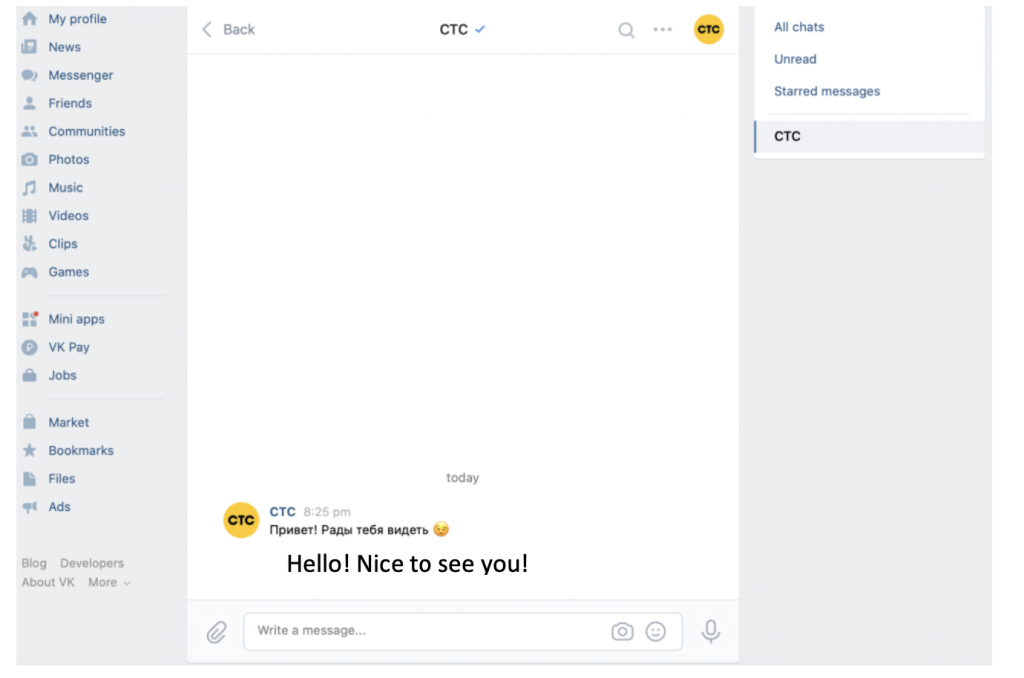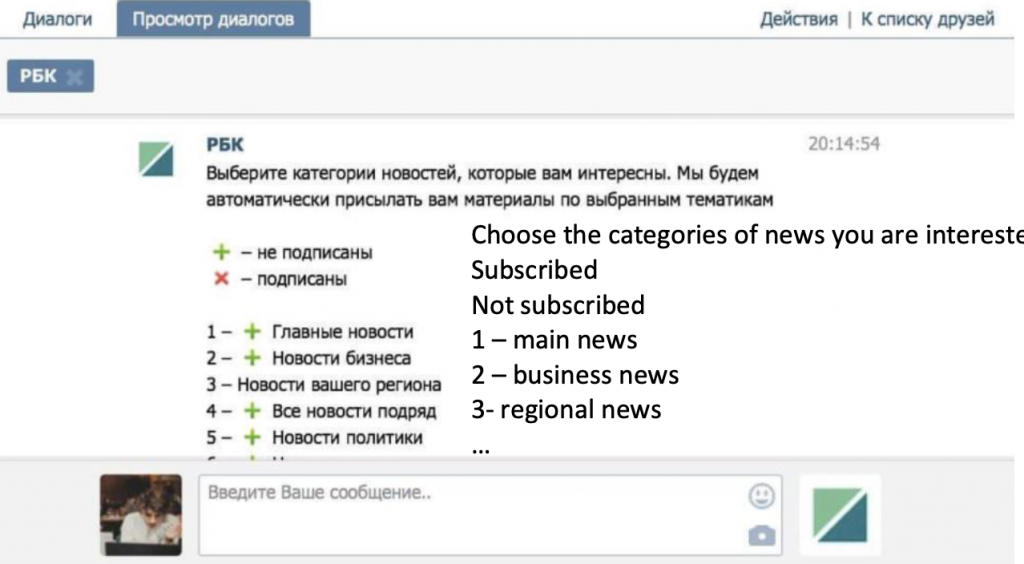PERSONALIZED JOURNALISM: THE USE OF CHATBOTS BY RUSSIAN MEDIA

The Internet is not a vending machine in which you throw a coin and then get what you want (Lovink, 2018). But what if it is?
One of the trends that appeared in late 2015 was the development of Internet robots, which were capable of talking to the user, sharing the latest news, and sending special offers. The creation of this technology has become a logical step in the development of the personalization process in mobile technology by analyzing the interests and habits of the users. Your personal assistant on the phone (Siri, Google Now, etc.) knows when it is better for you to wake up, what news you will be interested in, what route to work is more optimal, and many more. In addition, this new technology has been widely used in mass media – chatbots in messengers have become another channel for delivering information to the user, and this helped mass media to be in the closest relationship with the users possible. Infrastructure – “man-made systems and processes that function collaboratively and synergistically to produce and distribute a continuous flow of essential goods and services (Mattern, 2013), therefore, chatbots could easily be considered being an infrastructure, that helps mass media to deliver the information to the users.
Russian Media experience in using chatbots
Nowadays, chatbots are able to deliver content directly to the consumer in a super-operative manner. After programming and launch they do not require any additional attention from the editorial office or journalists, but nevertheless, allow media to constantly increase traffic to the media site.
In the fight for an audience mass media has started using chatbots in collaboration with social networks, while the latter introduced new features into their functionality that until recently were unavailable. Standardized components may also be reprogrammable within constraints by Users, allowing them to innovate new functions for machines that are composed, at least partially, ofpreexisting platform systems (Bratton). For example, the most popular Russian social platforms Vkontakte and Telegram have launched their bots to communicate with users. Using the open programming code of the social network (API), it is now possible to create a chatbot that will answer questions and execute simple commands right away. In addition, users that communicate with chatbots are not the “resource for data collection that vampirically feeds off of our identities, our “likes,” and our everyday habits” (Gitelman, 2013), as chatbots do not give users annoying content from third parties, but only give the content that users ask for.
Meduza and Telegram
Meduza was the very first Russian media to launch its chatbot. The robot appeared on the Telegram messenger platform on July 20, 2015, and is still available for installation. After receiving certain commands the service (the developer named the bot Alan) sends to the user the latest news, daily mailing list, the current exchange rate, a selection of news on chosen topics, or, after the command “/cat”, the bot sends random news about cats. “The function for which we made this bot,” – says in the service’s description.

“When we think of infrastructure in a common-sense way, infrastructure is that which runs ‘underneath’ actual structures” (Star, Leigh, Bowker, 2006). All the user can see is a chat interface and all he has is several commands that will help him to get the information from the bot that he needs. However, under this simple surface lays the whole infrastructure: the bot is built on a special platform called Elixir, which dynamic, functional language designed to build scalable and supported applications. The programmed bot works the following way: first it analyses the user’s request, then does the analysis of Meduza RSS-feed searching for the matching content and finally sends the message with a headline and the hyperlink to the article to the private chat with a user. Information is sent immediately after the user’s request, however, the chatbot also sends some information at a special time (e.g., “Evening Meduza” mailing list). Thus, the news is not lost in the information noise, but falls directly into the hands of the audience, by passing additional links in the communication chain. No more “soul-crushing lack of order” (Ramsay, 2010).
RBC, CTC holdings and Vkontakte
In the context of studying the specifics of chatbots in the media, I would like to note the development of RBC and CTC holdings.
It is possible to communicate with the bots of RBC and CTC through the social network Vkontakte – the user just needs to message the community on its public page and a friendly bot will start a conversation. The algorithms of these two bots are very different. CTC-bot can talk about the channel itself, the programs being broadcasted, as well as accept offers of cooperation.

RBC-bot is a functional algorithm that allows receiving the latest news, subscribing to the holding’s magazine, and receiving consultations on a number of issues (misprints on the website, purchasing the advertisement, cooperation, etc.). With the help of short commands, you can subscribe to the news feed from 12 sections of RBC: from the main news sections of RBC to the news about the fashion world.

Both of these algorithms are based on Botpult, a bot builder for VKontakte and Telegram. The service was launched in 2016, and quickly became popular among major online projects and media – thanks to the simple and clear interface, where almost any user can create a chatbot from basic templates like “Question-Answer”. The creators of Botpult completely “hidden” the entire programming process under a modern user interface.
Conclusion
The time of news “for everyone” has passed – today the audience wants to read and watch the personalized content about the topics that were sorted especially for them. There is a tendency in all media trends that journalism will be the most personalized service, and chatbots at the moment are a great example of this process.
Overall, bots can perform a lot of complex actions: order train tickets, take photos from a web camera at a certain time and send them to the user, translate the text into the desired language, have a conversation, and much more. However, many of these capabilities are not currently used by Russian media for a number of reasons. First of all, media as a service has not so many features that can be automated. Secondly, the trend of using automated algorithms has not yet reached mass distribution. Chatbots are still not that popular amongst Russian media. And finally, the audience has yet to explore and love the new channel for receiving news in this format.
Personalized journalism is becoming more and more popular day by day. As Lovink stated: “Search is the way we now live”, and that is completely true. However, I believe, that with such technologies as chatbots in social media, Russian and basically any media could help its audiences to navigate in this “information overloaded” (Lovink, 2008) world.
References
Gitelman, L. (ed.) 2013. Raw Data Is an Oxymoron. Cambridge: MIT Press. Introduction chapter.
H. Bratton, Benjamin. 2016. Platform and Stack, Model and Machine. MIT Press Scholarship Online.
Lovink, G. 2008. The Society of the Query and the Googlization of Our Lives: A Tribute to Joseph Weizenbaum.
Mattern, Shannon. 2013. Infrastructural Tourism. Places Journal, July.
Ramsay S. 2010. The Hermeneutics of Screwing Around. Or What to Do With One Million Books.
Star, Susan Leigh, and Geoffrey C. Bowker. 2006. How to Infrastructure. In Handbook of New Media: Social Shaping and Social Consequences of ICTs, edited by Leah A. Lievrouw and Sonia M. Livingstone, Updated student ed, 230–45. London: SAGE.
http://rbcholding.com
https://meduza.io/en
https://telegram.me/meduzaprobot
https://vk.me/ctc
https://vk.me/rbc
https://www.ctcmedia.ru